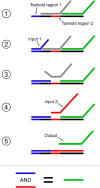Programmable Biomolecule-Mediated Processors
- PMID: 37864571
- PMCID: PMC10682996
- DOI: 10.1021/jacs.3c04142
Programmable Biomolecule-Mediated Processors
Abstract
Programmable biomolecule-mediated computing is a new computing paradigm as compared to contemporary electronic computing. It employs nucleic acids and analogous biomolecular structures as information-storing and -processing substrates to tackle computational problems. It is of great significance to investigate the various issues of programmable biomolecule-mediated processors that are capable of automatically processing, storing, and displaying information. This Perspective provides several conceptual designs of programmable biomolecule-mediated processors and provides some insights into potential future research directions for programmable biomolecule-mediated processors.
Conflict of interest statement
The authors declare no competing financial interest.
Figures





References
-
- Moore G. E. Cramming more components onto integrated circuits. Electronics 1965, 38, 114–117.
Publication types
LinkOut - more resources
Full Text Sources

